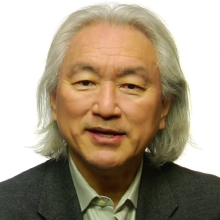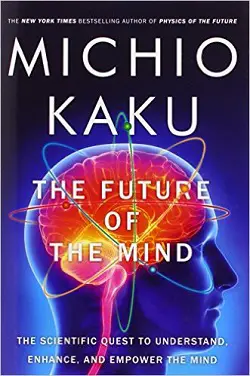|
TRANSLATE THIS ARTICLE
Integral World: Exploring Theories of Everything
An independent forum for a critical discussion of the integral philosophy of Ken Wilber
 Andrea Diem-Lane is a tenured Professor of Philosophy at Mt. San Antonio College, where she has been teaching since 1991. Professor Diem has published several scholarly books and articles, including The Gnostic Mystery and When Gods Decay. She is married to Dr. David Lane, with whom she has two children, Shaun-Michael and Kelly-Joseph. Andrea Diem-Lane is a tenured Professor of Philosophy at Mt. San Antonio College, where she has been teaching since 1991. Professor Diem has published several scholarly books and articles, including The Gnostic Mystery and When Gods Decay. She is married to Dr. David Lane, with whom she has two children, Shaun-Michael and Kelly-Joseph. The Future of the MindA ReviewAndrea Diem-Lane
We do not have to invent magical interpretations or invoke claims of the paranormal, when science itself offers almost more astounding ones but with evidence.
Michio Kaku in The Future of the Mind offers us a fascinating take on what may lie ahead for our world. While some of the predictions may seem fanciful at first, one should remember how far we have come in one century. If one could go back to the late 19th century (this is when my grandmother, Grace, was born) and imagine the future from then I suspect that one would not have dared to envision the technologically advanced world we have today with cell phones in our pockets and computers connecting everyone in the world. So when Kaku unveils his vision of the future, it is not surprising that great headways can be made dramatically and quickly. In many ways Kaku's text resembles Ray's Kurzweil's How to Create a Mind, as both futurists anticipate the creation of conscious computers. Kaku differs from Kurzweil, however, in arguing that while computers can attain awareness the human brain is unique from a computer. Why? The human brain, it seems, can rewire itself as it learns and a computer or robot cannot. And, unlike Kurzweil, he further agrees to some extent with Roger Penrose that quantum effects in the microtubules (and chaos theory) play a role in distinguishing the human brain from the computer. Despite these distinctions, Kaku suggests that a computer will eventually appear conscious and pass the Turing Test. In addition to conscious computers, Kaku thinks that in the future humans will be deeply impacted by adding computer parts to their own biology. The merging of artificial components to the human body may allow the paralyzed to walk (exoskeletons), the blind to see (artificial retinas), or the Alzheimer patient to remember (artificial hippocampus). If we want to acquire a new skill or knowledge, he argues, the memories for this might be imported directly into our enhanced hippocampus. Instead of studying for final exams, the college student need only add the new material to this region of the brain. The more we understand the anatomy of the human brain and what each part does the more ability we may have to digitally replace it, enhance it, or repair a deficiency. Besides adding on new artificial parts, Kaku imagines a world where surgery might be the thing of the past, as nanobots and nanoprobes heal us internally. Adult stem cells, he enumerates, can also play a role in regenerating brain tissue. Being constantly fine-tuned can allow for an extended, if not immortal, life. Immortality might also be achieved, argues Kaku, by uploading one's consciousness digitally, thus extending one's awareness indefinitely. At the very least, our memories and emotional states can be digitally saved for our descendants. The Armagedon scenario of Bill Joy in his article “Why The Future Does Not Need Us,” published in Wired magazine, is challenged here and a more positive and inspiring forecast is painted. We are entering, he says, a “Golden Age” of neuroscience. To some extent one can thank the BRAIN Project, supported by the Obama Administration in 2013, and the Human Brain project, under the European Union's commission. These two programs have generously funded brain research, specifically attempting to reverse engineer the human brain. Kaku expects amazing feats, such as filming our own dreams with portable MRIs the size of cell phones (some MRI research has shown promise here already) or entering another' dream as two sleeping brains are digitally connected. Instead of an Internet, there may be a “Brain Net” where we globally exchange thoughts, memories, and emotions with each other in seconds. He foresees avatars and surrogates as the norm. Artists may think of a work of art and it is instantly created. Kaku further conjectures that we might be able to experience “mind without matter” as we laser beam our consciousness through wormholes to other multiverses. As such, aliens may be part of our reality. (In his section on aliens the writer seductively adds a that it is possible that aliens and other realities living in parallel universes may right now be sharing our own living rooms with us, though we remain blissfully unaware.) In the past in my college philosophy course I used to assign Chet Raymo's book, Skeptics and True Believers, to give the students a sense of what I call the “wow effect.” Throughout Raymo's text he argues the idea that right in our present state we live in a marvelous and mysterious dimension and through science we can wake up to it. He offers numerous examples to attest to this. Thus, we do not have to invent magical interpretations or invoke claims of the paranormal, when science itself offers almost more astounding ones but with evidence. Sprinkled throughout his book, Kaku reveals remarkable revelations of science, but he more pointedly focuses on where science is taking us in the future. One of the main subjects of the Future of the Mind is understanding what human consciousness is and why it developed. According to Kaku, “human consciousness creates a model of the world and simulates it in time, by evaluating the past to simulate the future… to achieve a goal.” He compares this with other forms of consciousness and develops a distinction of four levels of consciousness: Level 0 (plants with no brain structure), Level 1 (reptiles with a brain stem), Level 2 (mammals with a limbic system and thus social relations), and Level 3 (humans with a prefrontal cortex and a well-developed concept of a future). What Kaku seems to be arguing here is that human consciousness is different than other forms, since we can “virtually simulate” a wide variety of scenarios. Years ago I wrote a similar thesis in my book, Darwin's DNA [Explaining Consciousness]: “In light of consciousness as a virtual simulator, any organism that can develop a mental 'pivot' tool will have a tremendous advantage in thinking of new and unexpected strategies. A curious, but hopefully, useful analogy can be derived here from a well-known sport. In basketball, for instance, a seasoned player knows well how to use his or her pivot 'foot.' Once one has finished dribbling the ball, he or she must keep one foot firmly set on the ground. The other foot, however, is free to 'pivot' or 'revolve' or 'turn' giving one options that the other foot doesn't. Asking 'why' is consciousness' pivot foot. It allows for a virtual simulator to turn and think of varying options and what they portend. It allows the mind to revolve and go into different directions.” Humans evaluate a variety of possibilities for a goal, agrees Kaku, and this gives us a tremendous evolutionary advantage because we can evade predators, find food, and also secure a mate. If Kaku's predictions are correct, by the end of our century, we may anticipate self-aware robots at Level 3 consciousness who can equally “simulate a future to achieve a goal.” He does warn, however, that as computers gain consciousness that we will need to create safeguards, such as programming computers and robots to be benevolent and with some ethical guidelines. Though there have been many models to understand human consciousness, from describing it as a clock, steam engine, telephone, transistor, etc., the author prefers to relate it to a CEO in charge of a company. Similar to a company, the brain is hierarchical with many parts working in different divisions. Yet, a CEO emerges out of the dorsolateral prefrontal cortex to make sense of all of the various feedback loops. A sense of I awareness, or a leader, appears to be in charge. Yet, while a CEO appears be directing the show, there are sub departments working under her that she is not even aware of. A similar analogy we can employ is an orchestra leader. As the music is being played by various instruments there surfaces the maestro who appears to orchestrate. And, interestingly, the brain may create a unified world, despite the different parts doing their job separately, as electromagnetism vibrates across the brain at a similar frequency of 40 cycles per second. While at a conference in India last year on consciousness I presented a paper on the illusions created by the brain, and coined the phrase “cerebral mirage” to explain it. Besides the illusion of an I, Kaku does a superb job offering other examples of the cerebral mirage. A favorite of mine was his discussion on color. He explains that the brain only sees three colors: red, green and blue. All of the other colors we imagine is the brain mixing these. As we observe the world, he adds, we have a huge black hole in our view due to our optic nerve. Yet, the brain compensates for this and we see a world that appears completely filled in. One of the more enjoyable aspects of this book is how in every chapter Kaku makes his material relatable as he connects his ideas to either a movie or a popular T.V. show. The films such as Inception with Leonardo DiCaprio, Liar Liar with Jim Carey, The Terminator with Arnold Swarzenegger, as well as past shows such as the Twlight Zone and Star Trek and from the current time the Big Bang Theory are among the many examples he draws from. Overall, this book is a wonderful read. It covers so many diverse topics from NDEs to mental illnesses to alien life to the scandalous MKULTRA program of the CIA. Yet, throughout all of these adventurous topics, Michio Kaka seems to consistently portray an astonishing future for humanity and one which titillates our imagination. |

